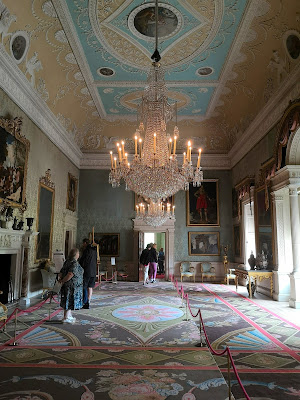 |
| Saltram (2014) |
Saltram is a Georgian mansion just outside Plymouth in Devon.
History
Before the civil war, Saltram was owned by the Bagge family. One of them, James Bagge, was a particularly disreputable character. He was an intimate friend of James I’s favourite, the Duke of Buckingham, who was a frequent visitor at Saltram, but he died in disgrace in 1638 after embezzling funds entrusted to him to supply the King’s fleet.
His son George was more respectable and became Deputy Governor of Plymouth, but as a Royalist, he had to forfeit the estate to Parliament after the civil war. When the monarchy was restored, the estate was given to Sir George Carteret who sold it to George Parker, a wealthy squire from Boringdon, in 1712.
The house remained in the Parker family until it was given to HM Treasury in lieu of death duties in 1957 and then passed into the care of the National Trust.
 |
| Saltram from the South West by Philip Hutchins Rogers (c1813) |
The Georgian connection
John Parker I (1703-1768)
George Parker bought Saltram in 1712 and let the house to tenants. His son John inherited in 1743, and he and his wife Catherine, daughter of the 1st Earl Poulett, decided to make Saltram their home. The house they inherited was a three-storey house built around a central courtyard. They commissioned a local architect to give the house a new look by adding three distinct classical façades to the existing building and they extensively remodelled the interior.
Lady Catherine had superior taste and was an early patron of Sir Joshua Reynolds who came from nearby Plympton. She was almost certainly responsible for the introduction of the fashionable Chinese wallpapers used in several of the first floor rooms.
 |
Chinese wallpaper, The Chinese Bedroom, Saltram (2014)
|
John Parker II (1734/5-1788)
John Parker II was MP for Bodmin and then Devon and was made 1st Baron Boringdon in 1784. He lived at Saltram with his second wife, Theresa Robinson, and continued to remodel the house and gardens. He appointed Robert Adam to design the Saloon and Library (now the Dining Room), and added new features to the gardens, such as the Orangery. John was good friends with Sir Joshua Reynolds who often visited Saltram and painted a number of portraits for the family.
 |
John Parker, 1st Baron Boringdon
by Sir Joshua Reynolds (1767) |
John Parker III (1772-1840)
John Parker III’s mother died when he was three years old and his aunt, Anne “Nanny” Robinson, looked after him and his sister Theresa at Saltram. He inherited on his father’s death in 1788, before he had reached his majority. George III and Queen Charlotte stayed at Saltram in August 1789 whilst they visited Plymouth and the surrounding area.
John married twice, firstly to Augusta Fane who scandalously eloped with Sir Arthur Paget, and secondly to Frances Talbot. In 1815, John was made Viscount Boringdon and Earl of Morley.
What can you see today?
• The Georgian façade of Saltram
 |
Entrance to Saltram (2014)
|
• Portraits by Sir Joshua Reynolds, such as this one of John Parker III and his sister Theresa as children.
 |
John Parker, later 1st Earl of Morley, and his sister Theresa
by Sir Joshua Reynolds (1779) (Photo 2014)
|
• Portraits by Angelica Kauffman, such as this self-portrait.
 |
Angelica Kauffman painted by herself (c1764) (Photo 2023)
|
• The Saloon designed by Robert Adam.
The first picture shows the original carpet. The second is from our visit in 2023, when part of the carpet is covered by a replica to enable visitors to enter the room. The colours of the replica were less vibrant than the original, and did not match up exactly because the original had stretched over time.
 |
The Saloon, Saltram (2014)
| | |
 |
The Saloon, Saltram (2023)
|
• The Dining Room designed by Robert Adam. It was originally the Library.
 |
The Dining Room, Saltram (2014)
|
• Rare Chinese wallpaper in several of the upstairs rooms
 |
The Chinese Bedroom, Saltram (2014)
|
• The Library, with a writing desk dating from c1700 believed to have belonged to Louis XIV.
 |
The Library, Saltram (2014)
|
• The Tudor courtyard, showing a glimpse of the original building.
 |
Tudor courtyard, Saltram (2014)
|
• The Orangery.
 |
The Orangery, Saltram (2014)
|
• The Amphitheatre on the banks of the river, thought to date from pre 1743.
 |
The Amphitheatre, Saltram, from across the river (2014)
|
Last visited: June 2023.
Rachel Knowles writes faith-based Regency romance and historical non-fiction. She has been sharing her research on this blog since 2011. Rachel lives in the beautiful Georgian seaside town of Weymouth, Dorset, on the south coast of England, with her husband, Andrew.
Find out more about Rachel's books and sign up for her newsletter here.
If you have enjoyed this blog and want to encourage us and help us to keep making our research freely available, please buy us a virtual cup of coffee by clicking the button below.
Sources used include:
Courthope, William, editor, Debrett's Complete Peerage of the United Kingdom of Great Britain and Ireland (1838)
Evans, Sian, Saltram (National Trust 2012)
Fletcher, Ronald, The Parkers at Saltram 1769-1789 (BBC 1970)
All photographs © Andrew Knowles - RegencyHistory.net
%202023%20v2.jpg)


%202023.jpg)






































